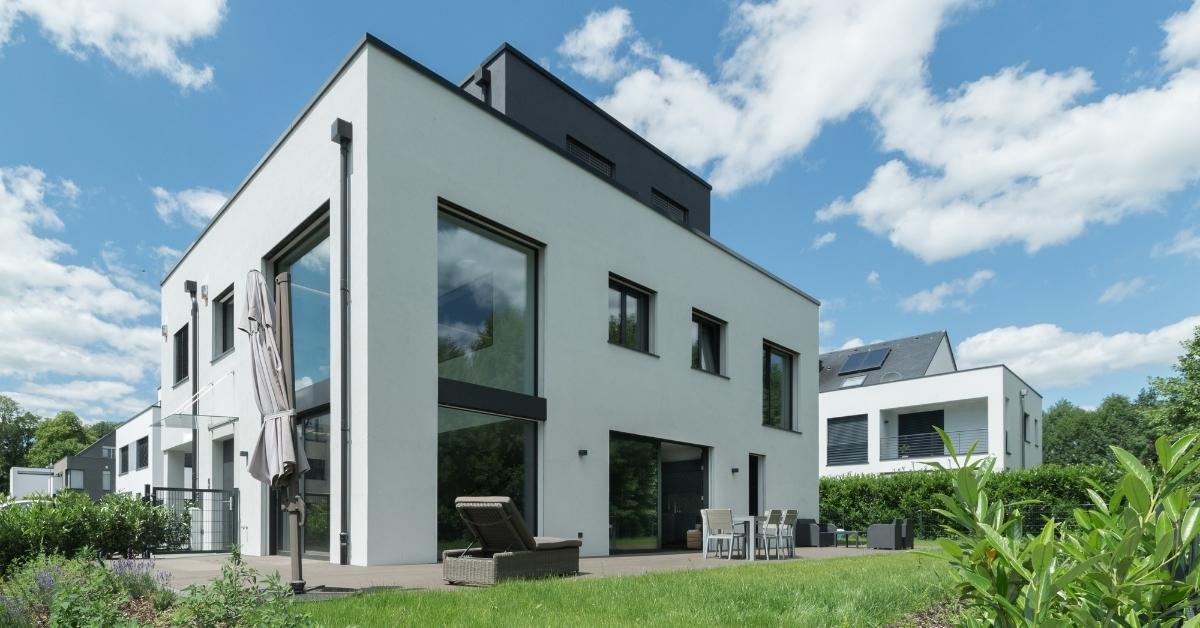The future of the building industry lies in dry construction.
Before reading the article, please find below the video of the interview with the principals and the installers of the Domaine du Château project, the star of today’s Case History.
The statement that we made at the beginning of the article is not simple rhetoric, but an actual fact as the innovations in product and process over the last two decades has helped it become popular and boosted performance to the point of making dry construction irreplaceable for an increasing number of applications, in all geographical and climatic areas.
The characteristics of this construction method involve multiple aspects of the construction chain, starting from the management of on-site safety, to then moving on to safety issues in the event of earthquake or fire, up to increasingly crucial aspects regarding the thermal and acoustic performance of buildings and their environmental impact.
In fact, today, at the centre of everything, there is respect for the environment that we live in and the need to avoid wasting materials, optimising construction-site processes to the maximum.
It is now clear that dry construction also represents sustainable solutions, as it greatly reduces waste and scrap from construction sites, contributes to logistical optimisation thanks to careful planning and favours careful management of materials as early as the design phase, choosing recyclable and sustainable materials more and more.
But before delving into the story of the Case History, Domaine du Château (a project that was started precisely to meet the needs of innovation and sustainability), let's look into the actual advantages of dry construction:
- Reversibility and predictability;
- Variety of materials and architectural versatility;
- Cost containment, thanks to lower execution risks;
- Shorter duration of the site;
- Greater quality and durability of the building;
- Greater capacity of integration with technological systems, aeration and air conditioning systems, water and gas systems;
- Eco-sustainability and energy efficiency;
- Lightweight and earthquake-proof.
If you are interested in learning more about every single advantage, to better understand the potential of this construction choice, read the article: “DRY CONSTRUCTION: WHAT ARE THE BENEFITS?”
Let's look into the Case History and understand what really makes this project innovative.
Domaine du Château, a true example of innovation in the competitive construction market
The Domaine du Château house is a residential building, a semi-detached villa located in Munsbach, in the south of Luxembourg.
It was built in 2018 (building started on 12 April 2018 and ended on 28 November 2018) and the customer of the project was Steel Home srl, with the executive design by Manni Green Tech srl.
"The Domain du Chateau construction site entailed a significant design activity by Manni Green Tech, as we were involved in the engineering of the entire architectural project developed for the customer.
We therefore had to deal with the structural design, creating, in an original way, a construction that integrated Light Steel Frame and hot rolled profiles and the choice of materials making up the entire envelope: walls, floors and roof.
It was a very interesting challenge, with LSF solutions, to have to observe the architectural design envisaged by the architect; for example, the knee beams used in the roof are original, which included a flat part attached to a gable part.
Every detail was designed and curated to the smallest detail to obtain the expected results so that the project and construction match exactly.
Another difficulty that the construction site presented and that we had to resolve was the very limited space we had available for the entire operation; in this site the space for storing materials was truly limited and they had to be delivered, according to a precise assembly schedule and then assembled quickly.
As for the structures, this was possible through close coordination with the construction company to whom we delivered walls and floors in pre-assembled elements, making it possible to assemble the structures in just three weeks.
The building and the systems were designed to ensure the very high levels of performance necessary to achieve the required Nzeb standards; highly performing stratified walls were developed both from a thermal and acoustic point of view, in particular for the partition walls between the two residential units - this is a two-family villa - which then had to guarantee a fire resistance of 90 minutes. These were also built entirely with dry construction." - Stated Enrico Benasciutti of Manni Green Tech.
How was the dwelling structured?
The house has two living units, side by side, built with a large and comfortable living area, which forms an open space with the kitchen on the ground floor. The open space is a key concept in this highly successful project, precisely in its attempt to follow a modern style that "merges" the living spaces.
Who spoke with us in Manni Green Tech's interview on the Domaine du Château Case History?
1. Andrea Bizzotto, founder and director of Steel Home srl, a real estate promotion and development company based in Luxembourg.
Andrea Bizzotto says, in the interview conducted by Manni Green Tech, that his objective was to invest in light steel prefabrication, for two reasons:
- To bring a new construction method to Luxembourg;
- To optimise construction costs and times;
The prefabrication method using light steel was highly appreciated for the construction of the Domaine du Château house, as construction times were significantly reduced and the project allowed for certain flexibility during construction, which made it possible to fulfil the customer’s various needs.
Manni Green Tech assisted me - confirms Andrea Bizzotto - with the development of the structural design and envelope, allowing me to meet the deadline perfectly.
2. Fausto Marchi, the surveyor representing New Living Srl, a contracting or installation company, based in Cecina.
The great advantage of the dry construction used for the Domaine du Château house was precisely how quickly the project was carried out. - Says Fausto Marchi
Furthermore - continues Fausto Marchi - having experimented with a different technique, compared to that of traditional reinforced concrete, it guarantees the structure with a better anti-seismic result.
The construction process began firstly in the shop with off-site pre-assembly activities and was then assembled on-site by a small number of people who worked on the project with passion and constancy.
3. Alessio Belli, partner of New Living, personally oversaw the assembly of the Domaine du Château house.
The advantage of dry construction - says Alessio Belli - with the prefabrication method using light steel is a clean, tidy and safe construction site.
Furthermore, the collaboration with Manni Green Tech for the delivery of the construction material, was easy and efficient. Everything arrived in Luxembourg on time to start construction.
Construction on the Domaine du Château house began, at the design level, in 2016, when a first structure was built in Umbria, basically a sort of real prototype in order to train operational teams prepared and, then, ready to leave for Luxembourg.
The Domaine du Château house is a clear example of how technological innovation is applied to construction and, how said construction is embraced by a modern concept of building and execution of construction projects optimised to achieve brilliant construction results.


